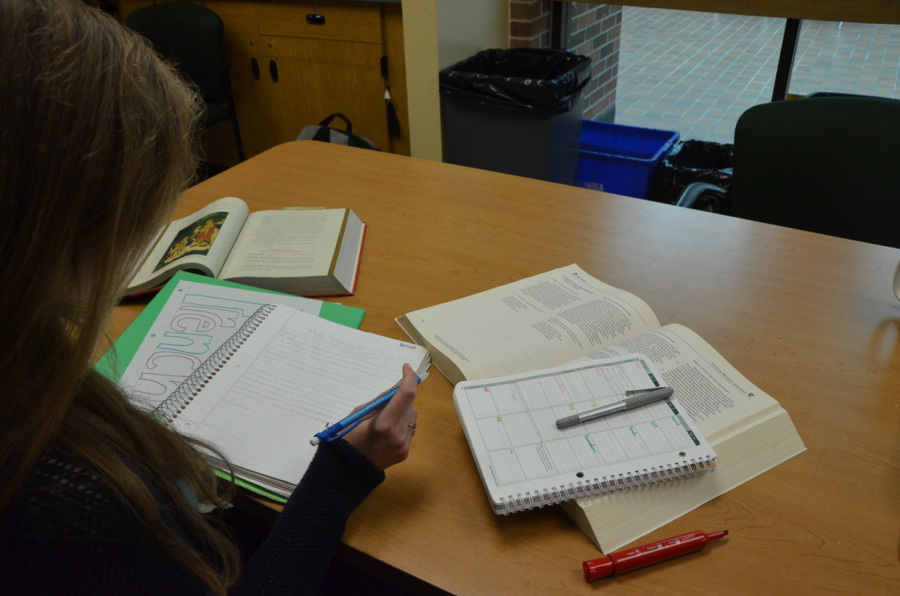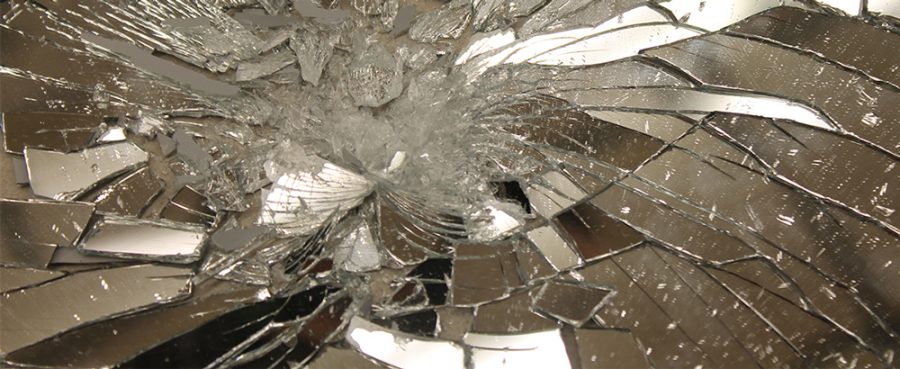[dropcap style=”flat” size=”5″ class=”A”]T[/dropcap]he clock strikes at midnight. Hands ruffle through papers and fumble for a pencil. Eyes dart through research articles and feet tap on the ground, counting down the seconds until all the work needs to be turned in the next day. Hurry, hurry, hurry.
A boy sits in his bedroom poring over countless binders, assignments and projects, but despite the endless reminders messily scribbled on note pads around him, he seemed to have overlooked the workload piling up. Or perhaps he lost track of what day it was, convinced it was still a week until the deadline. This situation was all too familiar—he dreaded the work and pushed his deadlines back too often to not know what was happening. It was a constant tug-of-war between want and need.
For junior Austin Roderick, this habit became a style of working that has stayed with him all throughout his childhood and continues to do so even in high school.
[/vc_column_inner] [/vc_column_inner]“I’ll tell myself things like, ‘I don’t have time,’ or ‘I’ll get it done later,’” Roderick said. “I’ve been procrastinating for as long as I can remember, but I would say middle school is where it really first began. Reaching middle school, this was when teachers really started to pay a little less attention to homework. They would assign it, and then there wasn’t much consequence for not doing it or turning it in late.”
[/vc_column_inner]“I’ll tell myself things like, ‘I don’t have time,’ or ‘I’ll get it done later,’” Roderick said. “I’ve been procrastinating for as long as I can remember, but I would say middle school is where it really first began. Reaching middle school, this was when teachers really started to pay a little less attention to homework. They would assign it, and then there wasn’t much consequence for not doing it or turning it in late.”
From big projects to daily homework assignments, Roderick procrastinates on it all, saying he does this on about “eight out of every 10 assignments.” Unsurprisingly, he is not alone.
Joseph Ferrari, a professor of psychology at DePaul University, said he found an estimated 20 percent of American men and women are “chronic procrastinators.” These are people who procrastinate at home, work and in relationships.
He also found that 70 percent of high school and college students procrastinate studying, reading and other school-related work. Although they delay in activities regarding school, he said they are not procrastinators if they only postpone one task.
“What [my research] shows is that academic procrastination is very situation-specific, there are a lot of people who procrastinate [on things like] income taxes and Christmas shopping,” Ferrari said. “The question is, what percentage of those people do it at other times of the year? You will find that 20 to 25 percent of [people] make this their lifestyle.”
Even with all of those people who struggle with this issue, people such as Roderick have little to no success shaking off the habit.
“I’ve tried to do ‘cold turkey’ and quit [delaying my work] altogether, [and] that lasted about 24 hours. I think [I continue to do this] because I know that I can produce the same quality of work by procrastinating as I can by not,” Roderick said. “I think the cause is more or less me telling myself that I’ve got other things to do. Another reason is that some teachers don’t have any punishments or point deductions for late work which takes away motivation for getting the work done on time.”
Art teacher Carrie Stephenson believes this thought process might contribute to procrastination in a relaxed environment like in her own class. Although some teachers at RBHS don’t have strict late work standards, this year the art department created a late work policy stating that once work is one day late, the student will get 10 percent of their project points deducted, and after the first week that number increases to 20 percent, and continues to do so the later the work gets turned in.
Stephenson believes this might make some students reconsider their work schedule and plan according to the deadlines.
Working at RBHS for three years and having attended high school here as well, she said procrastination has always been an issue for her students. She believes this is partly because of the class itself.
“In art, it’s a very laid-back class, [and] because it’s laid-back and it isn’t as structured, it’s pretty easy for student artists to work at their own pace,” Stephenson said. “They’ve got a deadline and they know that in advance, but [with] typical high school kids, if something else comes up, [the art is] put on the back burner because it’s something that’s easy and relatively relaxing and isn’t thought of as homework.”
Although she worries about her students’ procrastination, Stephenson said she also struggles with this issue, saying she is “right there with the kids.” For her, avoidance of work is fueled by her ability to perform well under pressure. Aside from her relatively positive outcome of procrastination, she has seen the negative impacts of this behavior in how it often affects her class dynamic.
“I think that the biggest thing that affects it is our due dates and how long projects take us. With AP [Art], we’re under a time deadline and we have very specific dates that we have to hit, and if during AP [Art] 1, if you don’t walk out of the classroom with 10 pieces, that puts you in a slight disadvantage when going into AP [Art] 2 because of that time crunch,” Stephenson said. “Because the students sometimes procrastinate or are lazy, the deadline gets shifted or they forget to turn something in on time. It just draws out the projects and minimizes the amount we can do that year.”
Despite Stephenson reminding her students when the due date is during class and stressing to them the importance of spending time outside of school to finish and helping to inspire students, she still deals with student procrastination. Even though she believes that every student delays work at one point or another, she also thinks students should have responsibility for their actions.
“I’m not going to text them to remind them,” Stephenson said. “It’s up to them at this point. They need to learn time management skills and they need to learn how to be a productive student.”
Aside from the short-term academic consequences of avoiding work and missing deadlines, Ferrari said there are many long term effects that negatively affect a person’s quality of life.
“You lose relationships, you miss out on so much of life if you’re a chronic procrastinator. They are great excuse-makers, they always have a reason for why they aren’t doing something and it’s never their fault,” Ferrari said. “What you need to do is start calling them out on these things. ‘No, you are responsible. It is your fault.’ We have to start [holding] people responsible for [their actions].”
Unlike the 20 percent of people who are “chronic procrastinators,” Roderick only postpones school work, and even then, he still gets it done, even if it is the night before the deadline.
“I don’t believe [my procrastination] has hurt me. I still get all my work done and turned in,” Roderick said. “I’ll still get high grades in my classes, and I’m as stress-free as ever.”
Although he has dealt with procrastination since middle school, he believes it doesn’t affect him negatively. But there is more to this behavior than action and outcome. There are two types of procrastinators. Passive procrastinators delay tasks until the deadline because of a lack of time management skills, while active procrastinators who like to work under pressure intentionally decide to postpone a task because they yield positive results and get things on time, according to a study from The Journal of Social Psychology. Active procrastinators are closer to non-procrastinators than passive ones in terms of their coping style and positive academic outcomes.
However, there are still those who are torn by procrastination and paralyzed by their indecision and inability to act on tasks in a given moment. Given the debilitating effects procrastination has on a significant portion of the population, Ferrari believes helping people to understand how their actions impact others will help to alleviate procrastination.
“What I encourage people to do is focus on the joys of life. Procrastinators just don’t understand that life is not about them, that when I delay it impacts somebody else,” Ferrari said. “Somebody else can’t get their job done, and that next person can’t get their job done. So it’s not about me, it’s about we.”
By Grace Vance[/vc_column_inner][/vc_row_inner][TS_VCSC_Icon_Flat_Button button_style=”ts-color-button-emerald-flat” button_align=”center” button_width=”100″ button_height=”50″ button_text=”Previous” button_change=”true” button_color=”#ffffff” font_size=”18″ icon=”ts-awesome-chevron-left” icon_change=”true” icon_color=”#ffffff” tooltip_html=”false” tooltip_position=”ts-simptip-position-top” tooltipster_offsetx=”0″ tooltipster_offsety=”0″ margin_top=”20″ margin_bottom=”20″ link=”url:http%3A%2F%2Fwww.bearingnews.org%2F2015%2F04%2Fchange-with-the-times%2F|title:Change%20with%20the%20Times|”]This article is the eighth in a series. Select “Next” to view the next article in the series, or “Previous” to view the preceding article.[TS_VCSC_Icon_Flat_Button button_style=”ts-color-button-emerald-flat” button_align=”center” button_width=”100″ button_height=”50″ button_text=”Next” button_change=”true” button_color=”#ffffff” font_size=”18″ icon=”ts-awesome-chevron-right” icon_change=”true” icon_color=”#ffffff” tooltip_html=”false” tooltip_position=”ts-simptip-position-top” tooltipster_offsetx=”0″ tooltipster_offsety=”0″ margin_top=”20″ margin_bottom=”20″ link=”url:http%3A%2F%2Fwww.bearingnews.org%2F2015%2F04%2Fthe-game-of-life%2F|title:The%20Game%20of%20Life|”]
A boy sits in his bedroom poring over countless binders, assignments and projects, but despite the endless reminders messily scribbled on note pads around him, he seemed to have overlooked the workload piling up. Or perhaps he lost track of what day it was, convinced it was still a week until the deadline. This situation was all too familiar—he dreaded the work and pushed his deadlines back too often to not know what was happening. It was a constant tug-of-war between want and need.
For junior Austin Roderick, this habit became a style of working that has stayed with him all throughout his childhood and continues to do so even in high school.
[/vc_column_inner]
 [/vc_column_inner]“I’ll tell myself things like, ‘I don’t have time,’ or ‘I’ll get it done later,’” Roderick said. “I’ve been procrastinating for as long as I can remember, but I would say middle school is where it really first began. Reaching middle school, this was when teachers really started to pay a little less attention to homework. They would assign it, and then there wasn’t much consequence for not doing it or turning it in late.”
[/vc_column_inner]“I’ll tell myself things like, ‘I don’t have time,’ or ‘I’ll get it done later,’” Roderick said. “I’ve been procrastinating for as long as I can remember, but I would say middle school is where it really first began. Reaching middle school, this was when teachers really started to pay a little less attention to homework. They would assign it, and then there wasn’t much consequence for not doing it or turning it in late.”From big projects to daily homework assignments, Roderick procrastinates on it all, saying he does this on about “eight out of every 10 assignments.” Unsurprisingly, he is not alone.
Joseph Ferrari, a professor of psychology at DePaul University, said he found an estimated 20 percent of American men and women are “chronic procrastinators.” These are people who procrastinate at home, work and in relationships.
He also found that 70 percent of high school and college students procrastinate studying, reading and other school-related work. Although they delay in activities regarding school, he said they are not procrastinators if they only postpone one task.
“What [my research] shows is that academic procrastination is very situation-specific, there are a lot of people who procrastinate [on things like] income taxes and Christmas shopping,” Ferrari said. “The question is, what percentage of those people do it at other times of the year? You will find that 20 to 25 percent of [people] make this their lifestyle.”
Even with all of those people who struggle with this issue, people such as Roderick have little to no success shaking off the habit.
“I’ve tried to do ‘cold turkey’ and quit [delaying my work] altogether, [and] that lasted about 24 hours. I think [I continue to do this] because I know that I can produce the same quality of work by procrastinating as I can by not,” Roderick said. “I think the cause is more or less me telling myself that I’ve got other things to do. Another reason is that some teachers don’t have any punishments or point deductions for late work which takes away motivation for getting the work done on time.”
Art teacher Carrie Stephenson believes this thought process might contribute to procrastination in a relaxed environment like in her own class. Although some teachers at RBHS don’t have strict late work standards, this year the art department created a late work policy stating that once work is one day late, the student will get 10 percent of their project points deducted, and after the first week that number increases to 20 percent, and continues to do so the later the work gets turned in.
Stephenson believes this might make some students reconsider their work schedule and plan according to the deadlines.
Working at RBHS for three years and having attended high school here as well, she said procrastination has always been an issue for her students. She believes this is partly because of the class itself.
“In art, it’s a very laid-back class, [and] because it’s laid-back and it isn’t as structured, it’s pretty easy for student artists to work at their own pace,” Stephenson said. “They’ve got a deadline and they know that in advance, but [with] typical high school kids, if something else comes up, [the art is] put on the back burner because it’s something that’s easy and relatively relaxing and isn’t thought of as homework.”
Although she worries about her students’ procrastination, Stephenson said she also struggles with this issue, saying she is “right there with the kids.” For her, avoidance of work is fueled by her ability to perform well under pressure. Aside from her relatively positive outcome of procrastination, she has seen the negative impacts of this behavior in how it often affects her class dynamic.
“I think that the biggest thing that affects it is our due dates and how long projects take us. With AP [Art], we’re under a time deadline and we have very specific dates that we have to hit, and if during AP [Art] 1, if you don’t walk out of the classroom with 10 pieces, that puts you in a slight disadvantage when going into AP [Art] 2 because of that time crunch,” Stephenson said. “Because the students sometimes procrastinate or are lazy, the deadline gets shifted or they forget to turn something in on time. It just draws out the projects and minimizes the amount we can do that year.”
Despite Stephenson reminding her students when the due date is during class and stressing to them the importance of spending time outside of school to finish and helping to inspire students, she still deals with student procrastination. Even though she believes that every student delays work at one point or another, she also thinks students should have responsibility for their actions.
“I’m not going to text them to remind them,” Stephenson said. “It’s up to them at this point. They need to learn time management skills and they need to learn how to be a productive student.”
Aside from the short-term academic consequences of avoiding work and missing deadlines, Ferrari said there are many long term effects that negatively affect a person’s quality of life.
“You lose relationships, you miss out on so much of life if you’re a chronic procrastinator. They are great excuse-makers, they always have a reason for why they aren’t doing something and it’s never their fault,” Ferrari said. “What you need to do is start calling them out on these things. ‘No, you are responsible. It is your fault.’ We have to start [holding] people responsible for [their actions].”
Unlike the 20 percent of people who are “chronic procrastinators,” Roderick only postpones school work, and even then, he still gets it done, even if it is the night before the deadline.
“I don’t believe [my procrastination] has hurt me. I still get all my work done and turned in,” Roderick said. “I’ll still get high grades in my classes, and I’m as stress-free as ever.”
Although he has dealt with procrastination since middle school, he believes it doesn’t affect him negatively. But there is more to this behavior than action and outcome. There are two types of procrastinators. Passive procrastinators delay tasks until the deadline because of a lack of time management skills, while active procrastinators who like to work under pressure intentionally decide to postpone a task because they yield positive results and get things on time, according to a study from The Journal of Social Psychology. Active procrastinators are closer to non-procrastinators than passive ones in terms of their coping style and positive academic outcomes.
However, there are still those who are torn by procrastination and paralyzed by their indecision and inability to act on tasks in a given moment. Given the debilitating effects procrastination has on a significant portion of the population, Ferrari believes helping people to understand how their actions impact others will help to alleviate procrastination.
“What I encourage people to do is focus on the joys of life. Procrastinators just don’t understand that life is not about them, that when I delay it impacts somebody else,” Ferrari said. “Somebody else can’t get their job done, and that next person can’t get their job done. So it’s not about me, it’s about we.”
By Grace Vance[/vc_column_inner][/vc_row_inner][TS_VCSC_Icon_Flat_Button button_style=”ts-color-button-emerald-flat” button_align=”center” button_width=”100″ button_height=”50″ button_text=”Previous” button_change=”true” button_color=”#ffffff” font_size=”18″ icon=”ts-awesome-chevron-left” icon_change=”true” icon_color=”#ffffff” tooltip_html=”false” tooltip_position=”ts-simptip-position-top” tooltipster_offsetx=”0″ tooltipster_offsety=”0″ margin_top=”20″ margin_bottom=”20″ link=”url:http%3A%2F%2Fwww.bearingnews.org%2F2015%2F04%2Fchange-with-the-times%2F|title:Change%20with%20the%20Times|”]This article is the eighth in a series. Select “Next” to view the next article in the series, or “Previous” to view the preceding article.[TS_VCSC_Icon_Flat_Button button_style=”ts-color-button-emerald-flat” button_align=”center” button_width=”100″ button_height=”50″ button_text=”Next” button_change=”true” button_color=”#ffffff” font_size=”18″ icon=”ts-awesome-chevron-right” icon_change=”true” icon_color=”#ffffff” tooltip_html=”false” tooltip_position=”ts-simptip-position-top” tooltipster_offsetx=”0″ tooltipster_offsety=”0″ margin_top=”20″ margin_bottom=”20″ link=”url:http%3A%2F%2Fwww.bearingnews.org%2F2015%2F04%2Fthe-game-of-life%2F|title:The%20Game%20of%20Life|”]


















































































